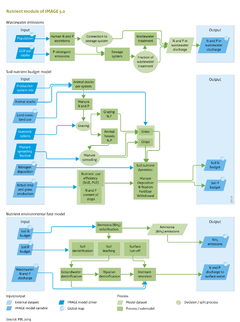Nutrients: Difference between revisions
Jump to navigation
Jump to search
m (Text replace - "Animal stock" to "Animal stocks") |
m (Text replace - "N and P discharge to surface water" to "N and P discharge to surface water - grid") |
||
| Line 5: | Line 5: | ||
|Reference=Bouwman et al., 2013ab; Galloway et al., 2004; Zhang et al., 2010; Diaz and Rosenberg, 2008; UNEP, 2002; Rabalais, 2002; | |Reference=Bouwman et al., 2013ab; Galloway et al., 2004; Zhang et al., 2010; Diaz and Rosenberg, 2008; UNEP, 2002; Rabalais, 2002; | ||
|InputVar=Population - grid; GDP per capita - grid; Land cover, land use - grid; Animal stocks; Livestock rations; Manure spreading fraction; Nitrogen deposition - grid; Actual crop and grass production - grid; Production system mix; Fertilizer use efficiency; | |InputVar=Population - grid; GDP per capita - grid; Land cover, land use - grid; Animal stocks; Livestock rations; Manure spreading fraction; Nitrogen deposition - grid; Actual crop and grass production - grid; Production system mix; Fertilizer use efficiency; | ||
|OutputVar=NH3 emissions - grid; N and P discharge to surface water; Soil N budget - grid; Soil P budget - grid; N and P in wastewater discharge - grid; | |OutputVar=NH3 emissions - grid; N and P discharge to surface water - grid; Soil N budget - grid; Soil P budget - grid; N and P in wastewater discharge - grid; | ||
|Description=Human activity has accelerated the Earth’s biogeochemical nitrogen (N) and phosphorus (P) cycles through increasing fertiliser use in agriculture ([[Bouwman et al., 2013ab]]). Increased use of N and P fertilisers has raised food production to support the rapidly growing world population, and increasing per capita consumption particularly of meat and milk ([[Galloway et al., 2004]]). Increased fertiliser use has contributed to ongoing increases in crop yields. | |Description=Human activity has accelerated the Earth’s biogeochemical nitrogen (N) and phosphorus (P) cycles through increasing fertiliser use in agriculture ([[Bouwman et al., 2013ab]]). Increased use of N and P fertilisers has raised food production to support the rapidly growing world population, and increasing per capita consumption particularly of meat and milk ([[Galloway et al., 2004]]). Increased fertiliser use has contributed to ongoing increases in crop yields. | ||
A side effect is that significant proportions of the mobilised N are lost through ambient emissions of ammonia (NH3), nitrous oxide (N2O) and nitric oxide (NO). Ammonia contributes to eutrophication and acidification when deposited on land. Nitric oxide plays a role in tropospheric ozone chemistry, and nitrous oxide is a potent greenhouse gas. Moreover, large proportions of mobilised N and P in watersheds enter the groundwater through leaching, and are released to surface waters through groundwater transport and surface runoff. Subsequently, nutrients in streams and rivers are transported to coastal marine systems, reduced by retention but augmented by releases from point sources, such as sewerage systems and industrial facilities. | A side effect is that significant proportions of the mobilised N are lost through ambient emissions of ammonia (NH3), nitrous oxide (N2O) and nitric oxide (NO). Ammonia contributes to eutrophication and acidification when deposited on land. Nitric oxide plays a role in tropospheric ozone chemistry, and nitrous oxide is a potent greenhouse gas. Moreover, large proportions of mobilised N and P in watersheds enter the groundwater through leaching, and are released to surface waters through groundwater transport and surface runoff. Subsequently, nutrients in streams and rivers are transported to coastal marine systems, reduced by retention but augmented by releases from point sources, such as sewerage systems and industrial facilities. | ||
Revision as of 17:02, 6 May 2014
| Component is implemented in: |
| Components: |
| Related IMAGE components |
| Projects/Applications |
| Key publications |
| References |
Key policy issues
- How will the increasing use of fertilisers affect terrestrial and marine ecosystems, with possible consequences for human health?
- To what extent can the negative impacts be reduced by more efficient nutrient management and wastewater treatment, while retaining the positive effects on food production and land productivity?
